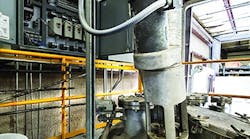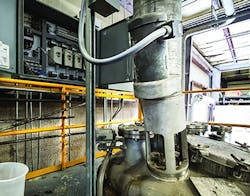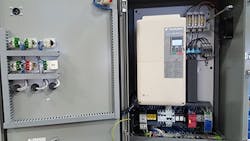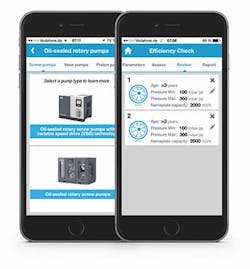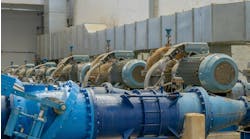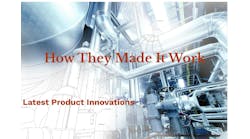The latest variable speed controllers bring motor control into the realm of the Industrial Internet of Things (IIoT) and can provide impressive savings. However, maximizing their impact requires a thorough understanding of the particular application, caution vendors.
“The most common reasons for implementing a variable frequency drive (VFD) to control a motor are to enable varying motor speeds for optimizing process or equipment function, to provide ramped starting and stopping speeds for reducing equipment wear, and for saving energy,” notes Kevin Kakascik, technical marketing engineer at AutomationDirect, Cumming, Ga.
“Applications vary, but VFDs are economical to use in many designs formerly controlled by standard motor starters.”
Because running a 100-hp motor for a year at full speed typically costs about $40,000 in electricity, it’s certainly worth checking to see if this cost can be cut, he stresses. Good candidates for VFD operation are motors that must operate with their output throttled down to meet varying demand. Installing a VFD on these motors can result in big savings, he points out, with payback periods often measured in months, particularly when utility company rebates are considered.
Some suppliers suggest a VFD is a no-brainer for every AC motor over a few horsepower, but Kakascik disagrees. “Instead, each application must be examined individually, as the devil is in the details,” he warns.
Many users also are beginning to take advantage of other extended configuration abilities and data that VFDs can provide to a control system, Kakascik adds, in effect making motor control part of the IIoT in many ways. Improved form factors, programmability and communications give end users more options than ever before (Figure 1), he explains.
Figure 1. IIoT capabilities add to the attractions of the drives. Source: AutomationDirect.
He offers some tips on determining the need for VFDs. For example, for new motor installations, specify the motor to meet both minimum and maximum requirements and estimate the time the motor runs at different speeds. Then, determine the installed cost of the VFD including required supplementary equipment for power factor correction, noise filtering, etc.
To assess savings, he suggests estimating the KWh cost at each of the selected motor speeds, including a 3% VFD loss, and translating these costs into yearly savings versus running the motor at full speed. Add in savings from reduced maintenance and from longer motor and other component life, all realized by running at lower speeds. In addition, include any rebates from the utility for VFD installations.
He counsels taking into consideration other issues such as torque loss, whether or not a braking resistor/braking unit should be used, motor lead length, and grounding of the VFD.
“A lot of people are unaware that when a VFD runs a motor above or below its base speed, it loses torque in most cases,” he explains.
One alternative to running a motor above base speed is to use a higher rpm motor and possibly oversize the motor if torque loss isn’t acceptable. Below base speed, sensor-less vector VFDs and flux vector VFDs are options.
Often braking resistors/braking units are overlooked, too. These can solve the regenerative issues found in situations involving high inertia loads.
Motor lead length frequently isn’t considered at all, he points out. Most manufacturers recommend a maximum length of around 70 ft. If this is exceeded, an installation might require a special VFD cable, load reactors and output filters to counter harmonics generated by the drive, motor and its leads.
Another important issue —VFD grounding — often is overlooked, laments Kakascik. Improper grounding not only is unsafe but also can prompt phantom problems in the form of nuisance faults that cause downtime: oftentimes, these phantom problems only show up after years of the VFD seeming to operate properly.
“If savings exceed costs significantly, then a VFD is a good idea. If they don’t, it’s not, at least strictly from an energy savings point of view — although VFDs are often needed for other reasons related to process control,” he concludes.
Better Processing
The main motivator for adopting variable speed drives (VSDs) such as steam turbines or electrical drives comes when a chemical plant requires accurate speed and process control to optimize overall plant performance, says Clayton Jurica, sales manager, steam turbine and compressor division, Mitsubishi Heavy Industries Compressor International, Houston.
“VSDs such as steam turbines have the capability to start-up under settle-out conditions in the compressors. This is a big benefit to process plants because there is no need for depressurization, which typically can take a long time and eats into plant revenue/profits,” he notes.
Incorporating steam turbines into an exothermic process plant also typically provides a significant energy advantage, Jurica adds.
“In this instance, turbines consume steam that is generated from the process to drive compressors, pumps, etc. As plants continuously age, we’re always working with owner/operators to replace older, less-efficient, turbines with our latest and most-efficient technologies. These upgrades save plant owners millions of dollars a year in steam usage as well as extending intervals between inspection and maintenance,” he stresses.
Technologies used during such “footprint replacements” include 3D impellers that improve upon the 2D versions manufactured in the early 1980s. Their use boosts polytrophic efficiency by 5–10% on average, reducing compression horsepower and associated utility costs while also cutting carbon dioxide emissions, according to Jurica.
He cites the example of a 300,000-t/yr chemical plant that, after installing a 3D impeller replacement, achieved a reduction of 4,838 hp in demand (a 14% decrease), a 14% drop in carbon dioxide emissions, and 31,000-lb/hr lower steam consumption (a 15% decline) — overall worth $1.24 million/yr.
Turning to electrical VFDs, Jurica notes that energy efficiency typically is high (>95%) and speed control makes sense for many operating points.
“By utilizing electrical VFDs, the plant is able to remove suction throttling valves, which reduces plant energy consumption. From a maintenance perspective, the electric drive solution has much lower OPEX [operating expenses] compared to some other drivers such as gas turbines. Typically, bearing inspections and filter maintenance are sufficient for reliable operation,” he adds.
Nevertheless, when looking at different mechanical drivers of equipment, it’s critical to evaluate specific project factors such as operational flexibility, OPEX, and actual operating experience, he cautions.
Another Perspective
Two key drivers are spurring VFD adoption, according to Edward Tom, drives product manager, Yaskawa America, Waukegan, Ill. “Firstly, customers are looking for a variable speed capability that doesn’t involve mechanical mechanisms and, secondly, to save energy,” he says. If the equipment uses an AC motor, the facility should consider a VFD, he counsels.
“The benefits will vary from application to application but, in general, you can lower maintenance cost with the soft-start capability of the drive, save energy by electronically operating at a lower speed versus using a mechanical method, and have tighter speed regulation of the equipment that can result in a better yield [Figure 2],” he explains.
Figure 2. VFDs can lower maintenance costs, save energy and increase process yield. Source: Yaskawa.
Yaskawa points to the success a rubber manufacturer in Tennessee has had with its MV1000 medium-voltage VFDs. Processing involves a batch sequence for mixing that lasts from 1–10 minutes with drive loading going from virtually zero to in excess of 100% during every batch. The company replaced the DC drives and motors on one mixer with a pair of MV1000 drives and 2,500-hp eight-pole motors.
Since startup two years ago, the MV1000 drives have maintained torque and speed control with full uptime and no nuisance trips. An efficiency analysis of the new drive and motor package has shown a 12–15% efficiency improvement compared with the old DC system.
“Yaskawa VFDs are able to provide the two necessary components needed to be part of the IIoT: connectivity and data,” Tom adds. The MV1000s’ Ethernet/IP communication option made data acquisition simple and straightforward. After reviewing the data, the local utility authority agreed the retrofit qualified for its energy efficiency incentive program. The rubber maker has subsequently used MV1000 drives on three additional retrofits.
New Developments
Advances in VFDs provide additional benefits, adds Tom. For example, Yaskawa’s latest product, the GA800 AC drive, has the ability to operate a synchronous reluctance motor in addition to the traditional induction or permanent magnet motor. It also provides highly flexible network communications and easy-to-use tools such as smartphone connectivity, he notes.
He also points to the company’s matrix-VFD-technology-based U1000 drive. Unlike a traditional VFD that converts AC (fixed voltage and frequency) to DC and then back to AC (variable voltage and frequency), the U1000 can convert AC directly to AC. “This makes it more energy efficient, resulting in very low line harmonics, and has the ability to regenerate energy back onto the line if needed,” he says.
Atlas Copco Compressor, Rock Hill, S.C., also is promoting new technology. It has introduced three new intelligent VSD+ vacuum pumps targeted at harsh industrial applications including conveying and drying. Besides boasting durable construction with corrosion-resistant materials and simple maintenance, the air-cooled, oil-free claw pumps feature integral VSD+ inverter drives that enable optimum performance and reduce power consumption, says the company.
Its new VSD+ app works with these new pumps as well as the existing GVS A VSD+ range. The app enables easy real-time monitoring and remote control of a pump from a smartphone (Figure 3). With just a few clicks, a user can precisely adjust the performance of a pump to current process requirements, which the company says ensures greater user-friendliness and noticeably more energy-efficient operation. Users have quick access to numerous operating parameters, including values such as inlet pressure, rotor speed, running hours and service intervals. The new app also makes it easy to commission the connected pumps through the target pressure, start/stop delay and stop level parameters, notes the company.
Figure 3. Users can monitor, control and even commission vacuum pumps in real time via new app. Source: Atlas Copco.
Meanwhile, ABB, Warrington, U.K., now is offering low-voltage VSDs for lease in the U.K. and Ireland. Drives from 3kW up to several megawatts are available 24/7, with same-day delivery and commissioning complete in a few hours. All units arrive fully maintained and pre-loaded with the latest firmware.
ABB cites a number of scenarios where this option is particularly compelling, including to cope with an emergency situation or unexpected failure, where leasing is a quick, low-cost way of keeping critical processes running while sourcing repairs or replacements; to provide extra capacity for short-term, semi-permanent or seasonal applications; and to prove predicted energy savings with leased VSDs on-site.
Seán Ottewell is Chemical Processing's Editor at Large. You can email him at [email protected].
